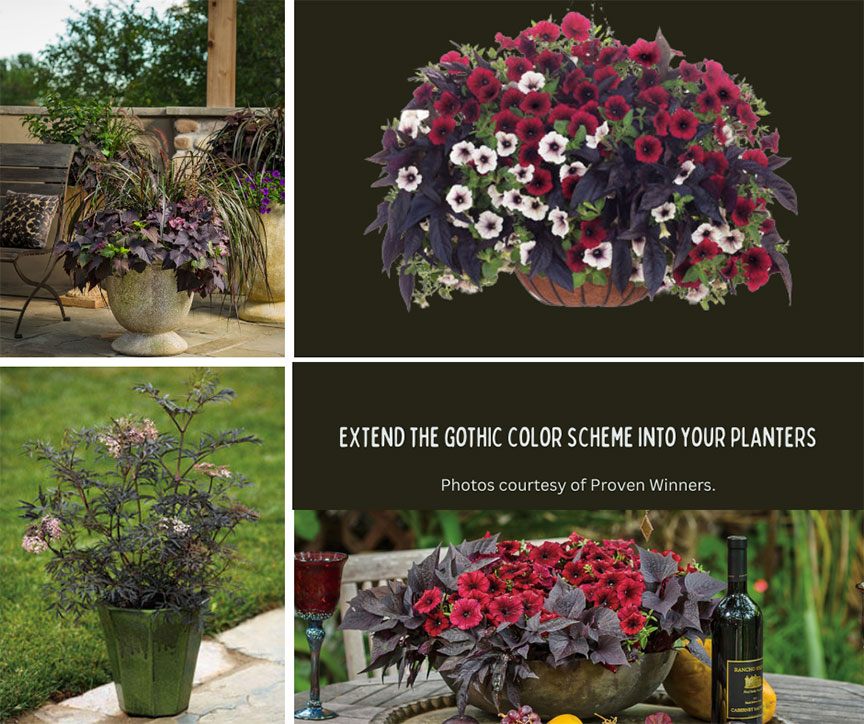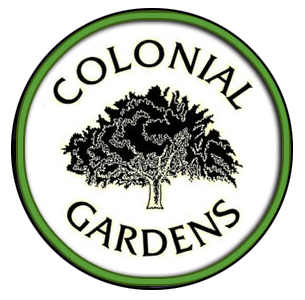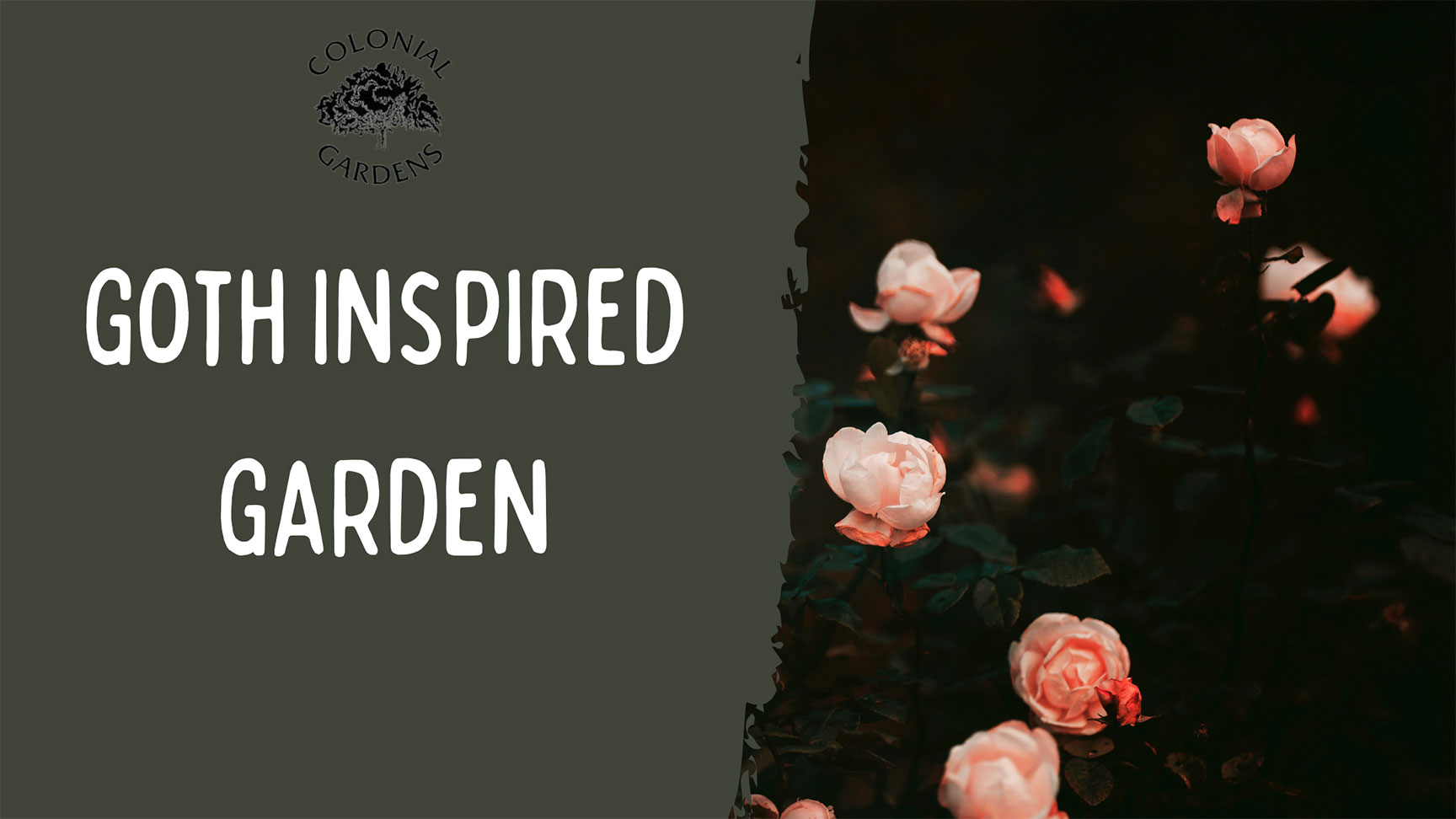
The “inspired garden” series has grown from the idea that garden inspiration can come from anywhere! Just as your sense of style or interior design may be influenced by the aesthetics of a particular location, time period, or vibe, your garden can also be an expression of your particular passions.
Predicted to be a popular garden trend this year, goth gardening is where I first got the idea for the “inspired garden” series.
The term ‘gothic’ has been used through the centuries to describe everything from architecture to literature to fashion. All of these uses inform the gothic style: the sweeping lines of vaulted arches, the ominous mystery and menace of gothic literature, and the dark colors and contrasts of goth fashion. We’re not going for a horror garden, but a darkly romantic garden that ruminates in the beauty of darkness. Don’t forget your sunscreen, gloves, and black parasol as you wander through your dream goth garden.
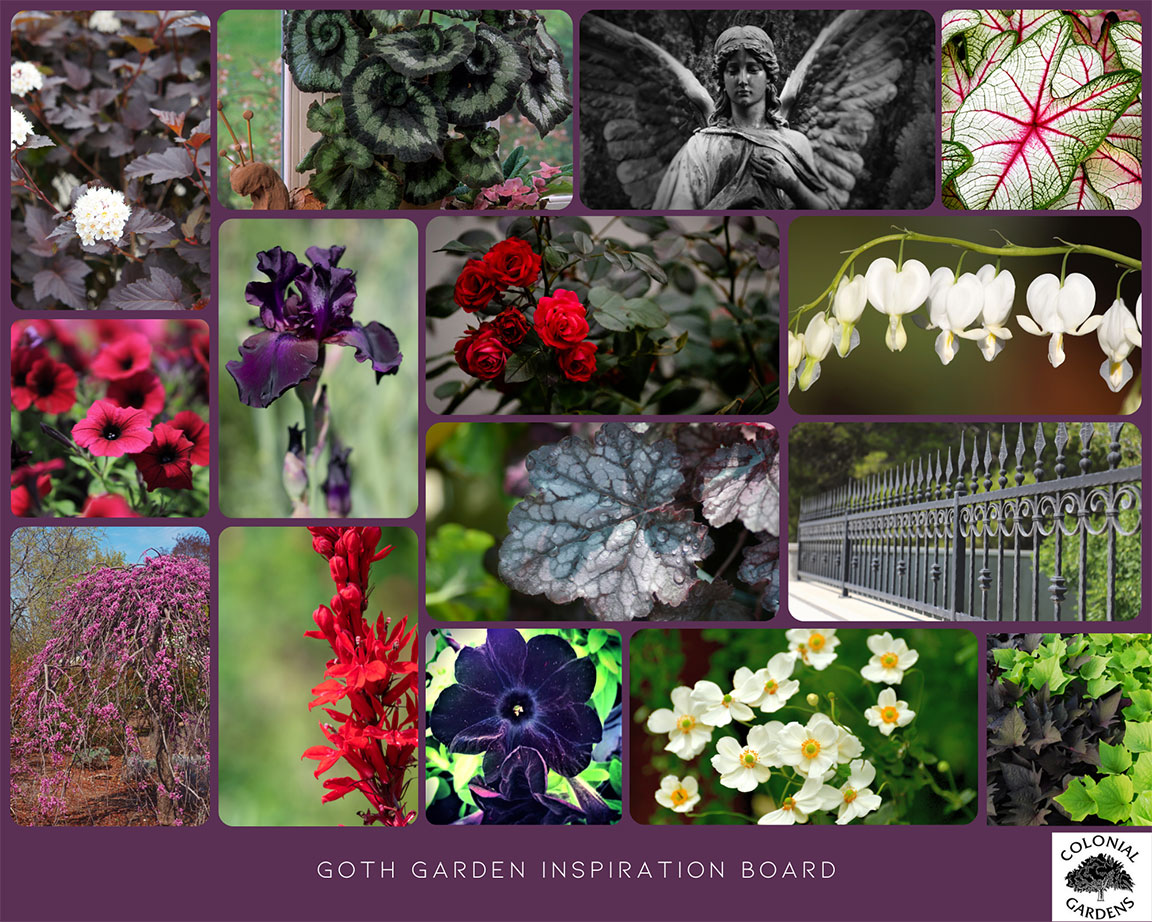
Essential Elements:
The color palette of the goth garden is decidedly dark. Focus on plants with foliage of deep greens and burgundies. Many new varieties of plants come with a darker foliage color to add variety to your landscape and make blooms pop. Speaking of blooms, we’re steering in a deep red direction with the occasional ghostly white. If you feel like your space is overwhelmed with blacks and purples, intersperse plants like Dusty Miller and Lambs’ Ear with silver foliage.
The form and vibe of a gothic garden can range from gracefully meandering to borderline abandoned. Look for romantic, curving lines for your beds that give the garden a flow against the straight lines of your home. Vining plants can ramble up posts and climb over archways. Weeping flowering trees cast a thoughtful, melancholy form. One thing not to plant: English Ivy. While this popular groundcover will definitely give gothic vibes, it is likely to get out of control, climbing neighboring trees and buildings, causing damage.
To add some structure to your goth garden, lean on the hardware and accessories. An iron rail fence (any condition will do!) will add an antique look to your garden. Statues of angels or saints evoke the vision of a cemetery, or the religious iconography of gothic lit and architecture. Cement urns will give you container options consistent with the monochromatic color scheme. These hardscaping elements will bring home the gothic theme to the casual observer.
The Plants:
Weeping Redbud or Cherry: Flowering trees are an excellent accent to a front yard, bringing spring color at a manageable size. After the blooms of spring have passed, the weeping forms of this tree will feature drooping branches. There are even some varieties, like Ruby Falls Redbud, that have purple or darker green leaves, which will jive nicely with your goth color scheme. Come fall, these deciduous trees will shed their leaves, revealing a weeping skeletal truck and branches.
Climbing Rose: No flower is more romantic than the rose. Bush roses will work. Choose a deep red or white rose to keep to your color palette. Pinks and corals may add too much of a cheery look (but remember, this is your garden! You do you!). Climbing roses will give you a chance to train them over an archway or up a trellis, pulling color upwards. You can choose wrought iron for the trellis to double down on that theme.
Rex Begonia: These shade annuals look like they are straight out of a Tim Burton movie with their spiral shape and dark colors. The fuzzy leaves of some begonia varieties make them matte, rather than glossy, which brings a new depth to the color palette of your garden. Begonias are best placed at the front of a shade garden or in containers. While some are notable exclusively for their foliage, others are good blooming options with delicate red flowers.
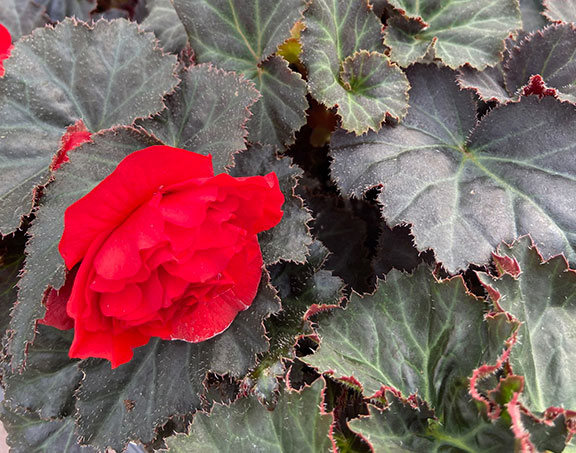
Petunia: Today petunias come in every color of the rainbow AND colors outside the rainbow like the velvety black “Black Magic.” You can also find cream colored petunias with thin black webbing lining in the interior of the flower, like “Supertunia Latte.” This variety evokes elegant cursive writing from a quill during the Victorian age, the perfect ornate detail for a monochromatic container. Another choice may be Supertunia Black Cherry, which morphs from a dark red to a black towards the neck of the flower.
Cardinal Flower: A native to our area, cardinal flower features a bright red column of blooms attractive to hummingbirds and butterflies. Add more dark foliage with the “Black Truffle” variety or just go straight native. Growing a few feet tall, these plants do great in partial shade. Cardinal flowers do great in unfertilized soil, so long as they have some drainage. Pop them towards the middle or back of your garden to add some height without them flopping into the pathways.
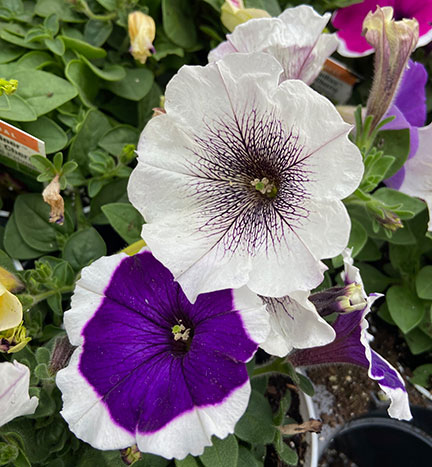
Heuchera: This shade loving plant is a staple of shade gardens due to its wide range of foliage colors. Choose a variety that has deep purple leaves like Blackout or Black Beauty. Heuchera produces dainty, downward facing flowers. Alternatively, if you need more height, try cimicifuga. Cimicifuga are shade tolerant plants with dark foliage and white spire blooms that do better in the middle to back of the bed, rather than the front.
Amaranth “Love Lies Bleeding”: Does anything sound more like an emo-punk song than Love Lies Bleeding? This unique looking annual droops and spills into dangling columns of red flowers. This annual towers up to 5 feet tall.
Black Veggies: A bit out of left field, but you can extend the gothic vibe to your food garden! While some edibles like eggplants and blackberries already fit your color palette, there are some varieties of tomatoes, peppers, and other veg that have dark foliage or fruit. Tomatoes like ‘Black Krim’ and ‘Indigo Rose’ are a dark purple at maturity. Amethyst Basil has both the taste and the dark beauty of a deep purple.
Hellebore: Hellebore, or the Lenten Rose, is one of the earliest spring bloomers that are hardy in our area. While they come in a variety of colors, there are certain varieties that produce a dark purple bloom. These perennials can act as a groundcover in shade to partially shaded areas of the garden. Their nodding flowers bend in sorrowful beauty towards the ground.
Weeping Japanese Maples: With a weeping form and dark, lacey leaves, weeping laceleaf Japanese maples bring the drama as a focal point to the goth garden.
Other options (look for ones with dark foliage):
- ‘Watchman’ Hollyhock
- ‘Black Knight’ Scabiosa
- ‘Black Velvet’ Nasturtium
- Dark Foliage Varieties of Sweet Potato Vine, Coleus, Dahlias, Cannas,
- Hardy Hibiscus, Elephant Ears, Ajuga,
- Andropogon ‘Blackhawk’
- Midnight Wine Weigela
- Black Lace Elderberry
- Winecraft Black or Dusty Maiden Smokebush
Silver Foliage: Lamb’s Ear, Dusty Miller, ‘Silver Falls’ Dichondra, Lavender, Cardoon
